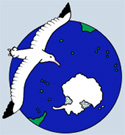 |
WANDERING ALBATROSS
|
 |

|
February 29 2008
South Georgia - St. Helena
Day 4
Position: 46 48'S 29 49'W Distance: 550 nm
|
 Grytviken seemed almost crowded when we returned there after weeks alone with South Georgia's wildlife.
We had all the usual pre-passage preparations to make such as servicing the engine, checking the rig, planning our route, stowing gear, etc.
In the evenings we enjoyed several sociable get togethers with friends from the museum and the King Edward Point base.
After just a few days back at the dock the weather forecast was looking promising:
A steady flow of westerly winds was approaching, some of the most consistent conditions we'd seen in weeks, and reluctant though we were to leave we knew this gap was too good to miss.
On our last day in South Georgia we walked around the coast to Penguin River for a final few hours with the penguins.
It was a glorious day and the mountains were magnificent, gleaming white against the blue sky with tendrils of cloud clinging to the summits.
A small group of king penguins had started a colony near the river mouth and to our delight there were two recently hatched chicks.
Almost downless, they are scrawny and wrinkled and its hard to believe they will ever grow into the stately beauty of the adults.
We watched them for a long time and it was touching to see how attentive the parents are, constantly preening and feeding the tiny grey bundles on their feet.
It seemed a perfect way to say goodbye to this special island.
Early the next morning we cast off from the dock and headed out into Cumberland Bay - we were on our way!
Grytviken seemed almost crowded when we returned there after weeks alone with South Georgia's wildlife.
We had all the usual pre-passage preparations to make such as servicing the engine, checking the rig, planning our route, stowing gear, etc.
In the evenings we enjoyed several sociable get togethers with friends from the museum and the King Edward Point base.
After just a few days back at the dock the weather forecast was looking promising:
A steady flow of westerly winds was approaching, some of the most consistent conditions we'd seen in weeks, and reluctant though we were to leave we knew this gap was too good to miss.
On our last day in South Georgia we walked around the coast to Penguin River for a final few hours with the penguins.
It was a glorious day and the mountains were magnificent, gleaming white against the blue sky with tendrils of cloud clinging to the summits.
A small group of king penguins had started a colony near the river mouth and to our delight there were two recently hatched chicks.
Almost downless, they are scrawny and wrinkled and its hard to believe they will ever grow into the stately beauty of the adults.
We watched them for a long time and it was touching to see how attentive the parents are, constantly preening and feeding the tiny grey bundles on their feet.
It seemed a perfect way to say goodbye to this special island.
Early the next morning we cast off from the dock and headed out into Cumberland Bay - we were on our way!
|
| |
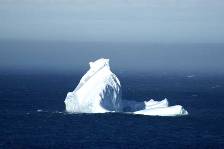 Williwaws stalked us across the broad bay and the clouds were racing overhead.
By the time we reached open water we had two reefs in both the main and the jib and in 25-30 knts of westerly wind we were going well.
We watched South Georgia disappear behind us and by mid-afternoon we were cocooned in thick fog.
For the first few hundred miles north of the island, until we had crossed the Antarctic Convergence, we were likely to encounter ice and had to keep a constant lookout.
Most bergs are fairly large (see photo) and show up reasonably well on radar, but as they break up they shed streams of smaller fragments, none of which would be fun to hit at 7 knots.
With wind and sea on the beam there was a lot of water coming across the deck so the watch keeper had a wet time standing up for hours to stare ahead.
For two nights we slowed down until barely making way as visibility was so poor, the half moon being mostly obscured by cloud.
In the end, we saw very little ice and about 250 miles north of South Georgia the sea temperature began to rise rapidly, indicating we had crossed the convergence and were out of the ice zone.
Since then we have been making good speed in rough conditions.
The wind has been up around 30 knts most of the time, gusting to 40, and we have reduced sail to a triple reefed main and staysail.
It is wild and exhilarating with albatrosses and petrels whisking past on stiff wings - they love the wind as much as we do!
Williwaws stalked us across the broad bay and the clouds were racing overhead.
By the time we reached open water we had two reefs in both the main and the jib and in 25-30 knts of westerly wind we were going well.
We watched South Georgia disappear behind us and by mid-afternoon we were cocooned in thick fog.
For the first few hundred miles north of the island, until we had crossed the Antarctic Convergence, we were likely to encounter ice and had to keep a constant lookout.
Most bergs are fairly large (see photo) and show up reasonably well on radar, but as they break up they shed streams of smaller fragments, none of which would be fun to hit at 7 knots.
With wind and sea on the beam there was a lot of water coming across the deck so the watch keeper had a wet time standing up for hours to stare ahead.
For two nights we slowed down until barely making way as visibility was so poor, the half moon being mostly obscured by cloud.
In the end, we saw very little ice and about 250 miles north of South Georgia the sea temperature began to rise rapidly, indicating we had crossed the convergence and were out of the ice zone.
Since then we have been making good speed in rough conditions.
The wind has been up around 30 knts most of the time, gusting to 40, and we have reduced sail to a triple reefed main and staysail.
It is wild and exhilarating with albatrosses and petrels whisking past on stiff wings - they love the wind as much as we do!
|
| |
March 5 2008
South Georgia - St. Helena
Day 9
Position: 40 21'S 18 30'W Distance: 1198 nm
|
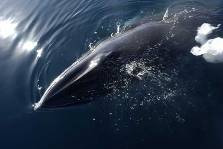 We've had very variable wind as we crossed the "Roaring Forties" and not nearly as much roaring as we expected.
A depression tracking north east brought near gale force westerly followed by southwesterly winds for a day but thereafter a small high came drifting in from the west and we've had lighter winds for the past few days.
Our heavy weather sails, which we will change once out of these latitudes, are the equivalent of our normal main and jib each with a reef in, so in the lower winds we are a bit under canvassed and have had the staysail out to give us that extra drive.
It has been pleasant sailing and the temperature has been rising steadily, both air and sea.
The butter is soft, the olive oil no longer solid and we have been shedding our thermals like a snake sheds its skin.
The wildlife has been fantastic and we have had two visits from whales.
A couple of days ago an Antarctic minke whale (see photo) shadowed the boat for three hours, swimming alongside, crossing our bow and surfacing astern with soft, whooshing blows.
It was about 10m long and easily kept pace with us, a dark shape surfing the big seas with its dorsal fin and occasionally a tail fluke slicing the surface.
Many times it came up so close we could see almost into its blowhole and we had a bird's eye view of the pointed snout and rostral ridge.
Its always special to catch a glimpse of the elusive creatures that inhabit the ocean but to have one stay with us for so long was remarkable.
The next morning a Sei whale, similar looking to the minke but larger and with a tall blow, approached at sunrise and circled the boat twice before continuing on its way.
We've had very variable wind as we crossed the "Roaring Forties" and not nearly as much roaring as we expected.
A depression tracking north east brought near gale force westerly followed by southwesterly winds for a day but thereafter a small high came drifting in from the west and we've had lighter winds for the past few days.
Our heavy weather sails, which we will change once out of these latitudes, are the equivalent of our normal main and jib each with a reef in, so in the lower winds we are a bit under canvassed and have had the staysail out to give us that extra drive.
It has been pleasant sailing and the temperature has been rising steadily, both air and sea.
The butter is soft, the olive oil no longer solid and we have been shedding our thermals like a snake sheds its skin.
The wildlife has been fantastic and we have had two visits from whales.
A couple of days ago an Antarctic minke whale (see photo) shadowed the boat for three hours, swimming alongside, crossing our bow and surfacing astern with soft, whooshing blows.
It was about 10m long and easily kept pace with us, a dark shape surfing the big seas with its dorsal fin and occasionally a tail fluke slicing the surface.
Many times it came up so close we could see almost into its blowhole and we had a bird's eye view of the pointed snout and rostral ridge.
Its always special to catch a glimpse of the elusive creatures that inhabit the ocean but to have one stay with us for so long was remarkable.
The next morning a Sei whale, similar looking to the minke but larger and with a tall blow, approached at sunrise and circled the boat twice before continuing on its way.
|
| |
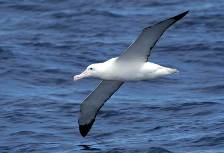 The settled weather has also brought clearer skies and we've been enjoying spectacular sunrises and sunsets.
The birds have been abundant and often we can spot 5 or 6 species at a glance.
Soft-plummaged and white-chinned petrels; sooty, black-browed, yellow-nosed and wandering albatrosses; prions, storm petrels and great shearwaters.
All swoop and soar around us, skimming the waves and making the most of the wind when it is there in a fantastic aerial display.
The wanderers (see photo) always impress us with their effortless gliding - the only time we ever see them flap their wings is when the wind is too light.
These majestic birds have numerous different plummage stages as they mature.
It takes many years for them to reach the final phase where they are almost all white apart from black wing tips, a black trailing edge to upper and lower wing and usually a bit of black in the tail.
As juveniles they are almost completely chocolate brown with only a white face mask giving them an odd, spectacled appearance.
We have seen several of these young birds and apart from their enormous size the scarcely resemble the adults at all - the 'ugly duckling' analogy springs to mind but they are all beautiful.
We are not looking forward to the day when we are too far north to have these wonderful companions any longer....
The settled weather has also brought clearer skies and we've been enjoying spectacular sunrises and sunsets.
The birds have been abundant and often we can spot 5 or 6 species at a glance.
Soft-plummaged and white-chinned petrels; sooty, black-browed, yellow-nosed and wandering albatrosses; prions, storm petrels and great shearwaters.
All swoop and soar around us, skimming the waves and making the most of the wind when it is there in a fantastic aerial display.
The wanderers (see photo) always impress us with their effortless gliding - the only time we ever see them flap their wings is when the wind is too light.
These majestic birds have numerous different plummage stages as they mature.
It takes many years for them to reach the final phase where they are almost all white apart from black wing tips, a black trailing edge to upper and lower wing and usually a bit of black in the tail.
As juveniles they are almost completely chocolate brown with only a white face mask giving them an odd, spectacled appearance.
We have seen several of these young birds and apart from their enormous size the scarcely resemble the adults at all - the 'ugly duckling' analogy springs to mind but they are all beautiful.
We are not looking forward to the day when we are too far north to have these wonderful companions any longer....
|
| |
March 10 2008
South Georgia - St. Helena
Day 14
Position: 35 21'S 10 39'W Distance: 1697 nm
|
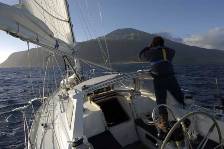 A small high has been almost stationary over us for the past few days, bringing very light winds.
With the breeze rarely over 15 knots and more often under 10 knots progress has been slow - not the conditions we were expecting in these latitudes.
On the plus side the weather has been good with balmy, almost tropical days interspersed with beautiful nights, the sky ablaze with stars.
Yesterday morning we were approaching the island of Tristan da Cunha at dawn and had a spectacular view of the island as the sun came up, turning the tendrils of mist that clung to the upper slopes a vivid pink.
High and volcanic it rises steeply from the sea, scored by gullies and clad in bright green vegetation.
With just a narrow strip of flat land where the village of Edinburgh is located, it reminded us of the Azorean fajas (see photo below).
There is no sheltered anchorage here, just an open roadstead with poor holding on a rocky bottom, and as the wind had picked up to 25 knots overnight we were doubtful whether we would be able to land.
But as the early morning sunshine touched the colourful rooves of the village we nudged in to have a closer look (see photo).
A small high has been almost stationary over us for the past few days, bringing very light winds.
With the breeze rarely over 15 knots and more often under 10 knots progress has been slow - not the conditions we were expecting in these latitudes.
On the plus side the weather has been good with balmy, almost tropical days interspersed with beautiful nights, the sky ablaze with stars.
Yesterday morning we were approaching the island of Tristan da Cunha at dawn and had a spectacular view of the island as the sun came up, turning the tendrils of mist that clung to the upper slopes a vivid pink.
High and volcanic it rises steeply from the sea, scored by gullies and clad in bright green vegetation.
With just a narrow strip of flat land where the village of Edinburgh is located, it reminded us of the Azorean fajas (see photo below).
There is no sheltered anchorage here, just an open roadstead with poor holding on a rocky bottom, and as the wind had picked up to 25 knots overnight we were doubtful whether we would be able to land.
But as the early morning sunshine touched the colourful rooves of the village we nudged in to have a closer look (see photo).
|
| |
 Lying roughly midway between Africa and South America and over 1000 miles south of St Helena, the island belongs to the UK.
With a population of about 250 this must be one of the most remote inhabited islands in the world.
The wind had whipped the sea into foaming crests and the ocean swell was crashing onto the black rocks of the beach.
There was no way we could anchor or launch the dinghy at that stage but thinking we would heave to for a few hours in the hopes that conditons would improve,
Gary spoke to the harbour master and the immigration official on the VHF radio to find out what the form was for coming ashore.
We were surprised to be told that we would not be allowed to land in any case - due to some work being done on the small harbour, "Health & Safety" regulations dictated that the entire waterfront had been declared out of bounds.
After our initial disappointment, we had to chuckle at the irony:
Having just sailed 1500 miles through the Southern Ocean we couldn't set foot ashore in case we fell down a hole or got run over by a reversing machine!
The petty bureaucracy of the outside world seemed out of place in this isolated place, but this time no amount of logic could persuade the officials to bend the rules.
Lying roughly midway between Africa and South America and over 1000 miles south of St Helena, the island belongs to the UK.
With a population of about 250 this must be one of the most remote inhabited islands in the world.
The wind had whipped the sea into foaming crests and the ocean swell was crashing onto the black rocks of the beach.
There was no way we could anchor or launch the dinghy at that stage but thinking we would heave to for a few hours in the hopes that conditons would improve,
Gary spoke to the harbour master and the immigration official on the VHF radio to find out what the form was for coming ashore.
We were surprised to be told that we would not be allowed to land in any case - due to some work being done on the small harbour, "Health & Safety" regulations dictated that the entire waterfront had been declared out of bounds.
After our initial disappointment, we had to chuckle at the irony:
Having just sailed 1500 miles through the Southern Ocean we couldn't set foot ashore in case we fell down a hole or got run over by a reversing machine!
The petty bureaucracy of the outside world seemed out of place in this isolated place, but this time no amount of logic could persuade the officials to bend the rules.
|
| |
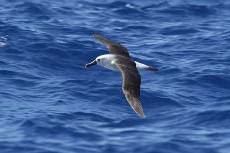 One of the main reasons we wanted to stop at Tristan da Cunha was to see yellow-nosed albatrosses at their breeding site.
This species has a very restricted breeding range and nests only on islands in the Tristan archipelago (Tristan, Inaccessible and Nightingale) and at Gough Island about 250 miles to the southeast.
The majority of the colonies are on Tristan itself.
We spent several hours hove to about a quarter mile offshore and were rewarded by a constant stream of these beautiful birds soaring past.
They are particularly pretty with dark upper wings, a white rump, white underside, a pale grey wash across their heads and a bright yellow stripe on top of an otherwise blackish bill (see photo).
Like so many albatross species, these birds are listed as "endangered" due to a rapid rate of decline over the last 20-30 years.
The primary threat is from longline and trawling operations off the coasts of Brazil and southern Africa, where the birds tend to forage in the rich waters.
The good news is that an Albatross Task Force operates in both these key regions, part of the international "Save the Albatross" campaign, teaching fishermen how to implement simple but effective measures to prevent seabird mortality.
To learn more about their vital work and how you can help support it, visit www.savethealbatross.net.
One of the main reasons we wanted to stop at Tristan da Cunha was to see yellow-nosed albatrosses at their breeding site.
This species has a very restricted breeding range and nests only on islands in the Tristan archipelago (Tristan, Inaccessible and Nightingale) and at Gough Island about 250 miles to the southeast.
The majority of the colonies are on Tristan itself.
We spent several hours hove to about a quarter mile offshore and were rewarded by a constant stream of these beautiful birds soaring past.
They are particularly pretty with dark upper wings, a white rump, white underside, a pale grey wash across their heads and a bright yellow stripe on top of an otherwise blackish bill (see photo).
Like so many albatross species, these birds are listed as "endangered" due to a rapid rate of decline over the last 20-30 years.
The primary threat is from longline and trawling operations off the coasts of Brazil and southern Africa, where the birds tend to forage in the rich waters.
The good news is that an Albatross Task Force operates in both these key regions, part of the international "Save the Albatross" campaign, teaching fishermen how to implement simple but effective measures to prevent seabird mortality.
To learn more about their vital work and how you can help support it, visit www.savethealbatross.net.
|
| |
March 17 2008
South Georgia - St. Helena
Day 21
Position: 21 57'S 6 50'W Distance: 2548 nm
|
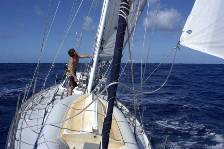 We are truly in the tropics now, having crossed the Tropic of Capricorn last night.
The water is over 20 degrees C now and schools of flying fish burst from our bow wave to go glittering away like magical birds.
We are sailing through a brilliant blue world (see photo), the sky cornflowers and the sea sapphires, with occasional black squalls that trail veils of rain.
A day away from Tristan da Cunha we were becalmed as the center of the high caught up with us, so took the opportunity to change sails.
Taking down our heavy weather jib and main, we replaced them with our normal, larger sails.
Since then we have had mainly light winds with short periods of stonger winds that necessitated a reef or two.
We're not going to break any speed records on this passage but have been enjoying the slow pace and the rhythmn of the sea.
The days have started to blur together in the routine of watches, sunrises and sunsets.
For 5 days we had east-northeast wind and in order to keep on course for St Helena we had to pinch and squeeze, sailing as hard on the wind as we could, sacrificing speed and comfort in favour of remaining on our rhumb line.
Each day the forecast promised a shift to the east-southeast - the long awaited tradewinds - but until yesterday they eluded us.
At last we have been able to crack off the sheets a bit and fall off to put the wind on the beam - much more comfortable!
The waxing moon keeps us company at night, casting a silver path across the sea and lighting the boat in monchrome shades, almost as bright as day.
We are truly in the tropics now, having crossed the Tropic of Capricorn last night.
The water is over 20 degrees C now and schools of flying fish burst from our bow wave to go glittering away like magical birds.
We are sailing through a brilliant blue world (see photo), the sky cornflowers and the sea sapphires, with occasional black squalls that trail veils of rain.
A day away from Tristan da Cunha we were becalmed as the center of the high caught up with us, so took the opportunity to change sails.
Taking down our heavy weather jib and main, we replaced them with our normal, larger sails.
Since then we have had mainly light winds with short periods of stonger winds that necessitated a reef or two.
We're not going to break any speed records on this passage but have been enjoying the slow pace and the rhythmn of the sea.
The days have started to blur together in the routine of watches, sunrises and sunsets.
For 5 days we had east-northeast wind and in order to keep on course for St Helena we had to pinch and squeeze, sailing as hard on the wind as we could, sacrificing speed and comfort in favour of remaining on our rhumb line.
Each day the forecast promised a shift to the east-southeast - the long awaited tradewinds - but until yesterday they eluded us.
At last we have been able to crack off the sheets a bit and fall off to put the wind on the beam - much more comfortable!
The waxing moon keeps us company at night, casting a silver path across the sea and lighting the boat in monchrome shades, almost as bright as day.
|
| |
March 21 2008
South Georgia - St. Helena
Day 25 - arrived St. Helena
Position: 15 55'S 5 43'W Distance: 2922 nm
|
 These past few days have been slow with barely enough wind to keep us moving. Even the occasional squalls have brought no increase in wind. But it is beautiful out here with fantastic sunrises and sunsets and a nearly full moon lighting up the night (see photo).
At change of watch at 0100 this morning we could just make out the shadowy shape of St Helena on the horizon. A short time later we picked up a "passenger" - a noddy came fluttering in to land on the pushpit with much loud squawking. It stayed there until very first light then vanished like a wraith.
The island was veiled in rain and a rich, earthy smell was noticeable as we closed the coast. Shafts of sunlight probed through the low clouds like spotlights, picking out patches of bright red earth and the verdant green of dense vegetation near the top of the island. A constant stream of noddies and fairy terns flew past, heading for their nesting sites on the steep cliffs. The water is deep close to the shore so we were able to keep about 1/2 a mile off as we motorsailed the last few miles to the anchorage off Jamestown. There were 8 other yachts there - the most we have seen for a long time - and we dropped the hook near them. It was a special moment for us as this was our first landfall after our first ever ocean passage 17 years ago and we are looking forward to revisiting the island.
These past few days have been slow with barely enough wind to keep us moving. Even the occasional squalls have brought no increase in wind. But it is beautiful out here with fantastic sunrises and sunsets and a nearly full moon lighting up the night (see photo).
At change of watch at 0100 this morning we could just make out the shadowy shape of St Helena on the horizon. A short time later we picked up a "passenger" - a noddy came fluttering in to land on the pushpit with much loud squawking. It stayed there until very first light then vanished like a wraith.
The island was veiled in rain and a rich, earthy smell was noticeable as we closed the coast. Shafts of sunlight probed through the low clouds like spotlights, picking out patches of bright red earth and the verdant green of dense vegetation near the top of the island. A constant stream of noddies and fairy terns flew past, heading for their nesting sites on the steep cliffs. The water is deep close to the shore so we were able to keep about 1/2 a mile off as we motorsailed the last few miles to the anchorage off Jamestown. There were 8 other yachts there - the most we have seen for a long time - and we dropped the hook near them. It was a special moment for us as this was our first landfall after our first ever ocean passage 17 years ago and we are looking forward to revisiting the island.
|
| |
March 31 2008
St Helena Island
|
 The main town on St Helena, Jamestown, lies cradled at the bottom of a steep sided valley (see photo) Although it was Good Friday (a fact we only discovered when we called up St Helena Radio to announce our arrival) and everything in Jamestown was shut, we couldn't wait to get ashore for a walk so after a long anticipated swim and a short nap we launched the dinghy and rowed in. Landing in St Helena can be a real challenge as the ever present swell surges against the concrete pier and there is nowhere to secure the dinghy other than to haul it out of the water and onto the jetty. Normally there is a ferry service operating and the experienced boatmen make coming alongside seem easy, guaging the waves with an expert eye. But we were on our own today. There are ropes secured at the end of the pier to help you pull yourself up and it is all in the timing, riding a surge in, grabbing the rope and scrambling out with the dinghy painter, letting the sea suck the boat back out then pulling it back on the next wave so the other person can jump out and then both drag the dinghy up onto the jetty. Exciting moments!
The main town on St Helena, Jamestown, lies cradled at the bottom of a steep sided valley (see photo) Although it was Good Friday (a fact we only discovered when we called up St Helena Radio to announce our arrival) and everything in Jamestown was shut, we couldn't wait to get ashore for a walk so after a long anticipated swim and a short nap we launched the dinghy and rowed in. Landing in St Helena can be a real challenge as the ever present swell surges against the concrete pier and there is nowhere to secure the dinghy other than to haul it out of the water and onto the jetty. Normally there is a ferry service operating and the experienced boatmen make coming alongside seem easy, guaging the waves with an expert eye. But we were on our own today. There are ropes secured at the end of the pier to help you pull yourself up and it is all in the timing, riding a surge in, grabbing the rope and scrambling out with the dinghy painter, letting the sea suck the boat back out then pulling it back on the next wave so the other person can jump out and then both drag the dinghy up onto the jetty. Exciting moments!
|
| |
 The main street is lined on both sides by picturesque and colourful buildings, many of them several hundred years old. There is a strong sense of welcome from the friendly people and everyone greets each other as they pass in the street. St Helena does not have an airport - yet - so the only way to visit is by sea. A few cruise ships stop here for a day at a time and around 100 yachts sail in each season but the only other visitors must come on the supply ship from Cape Town or Ascension. Thanks in part to this remoteness the locals have a charming innocence, a deep pride in their island and a fun-loving, unhurried lifestyle. We were surprised but pleased to find that very little had changed since we were here 17 years ago. To stretch our legs after 25 days at sea we tackled the 699 steps of Jacobs Ladder, an amazing staircase up the steep, rocky side of the valley (see photo) spanning 600' between Jamestown at the bottom and the village of Half-tree Hollow at the top. Built in 1829 it was originally an 'inclined plane', with tracks on either side of the steps upon which wagons could be hauled, carrying manure up and goods down. Nowadays it is a fitness challenge for islanders and visitors alike with the record ascent made by a marathon runner in something like 5 minutes!
The main street is lined on both sides by picturesque and colourful buildings, many of them several hundred years old. There is a strong sense of welcome from the friendly people and everyone greets each other as they pass in the street. St Helena does not have an airport - yet - so the only way to visit is by sea. A few cruise ships stop here for a day at a time and around 100 yachts sail in each season but the only other visitors must come on the supply ship from Cape Town or Ascension. Thanks in part to this remoteness the locals have a charming innocence, a deep pride in their island and a fun-loving, unhurried lifestyle. We were surprised but pleased to find that very little had changed since we were here 17 years ago. To stretch our legs after 25 days at sea we tackled the 699 steps of Jacobs Ladder, an amazing staircase up the steep, rocky side of the valley (see photo) spanning 600' between Jamestown at the bottom and the village of Half-tree Hollow at the top. Built in 1829 it was originally an 'inclined plane', with tracks on either side of the steps upon which wagons could be hauled, carrying manure up and goods down. Nowadays it is a fitness challenge for islanders and visitors alike with the record ascent made by a marathon runner in something like 5 minutes!
|
| |
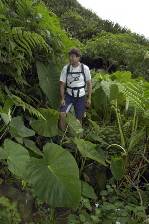 Other than some fresh provisioning and taking on diesel - brought out in 44 gallon drums by the ferryman and transferred with a hand pump - the only pressing boat job we needed to do was to scrub the bottom. The anti-fouling is now 2 years old (normally we repaint it every year) and we had a lot of algae growth below the waterline. In some places it was very thick and definitely slowed us down by at least a knot on the last passage. Over several days we snorkelled and scrubbed it, a pleasure in the warm blue water. After this we hired a car for 3 days and explored the island. St Helena is 820m at its highest point and the upper slopes are cloaked in dense vegetation, nurtured by the almost constant low cloud and mist that seem to form over the high ground. Diana's Peak National Park encompasses the top peaks and protects some of the island's unique flora such as the tree fern and cabbage tree. We went on a long walk along an almost disused and very overgrown trail where we felt as if we were deep in a jungle (see photo). On the underside of huge green leaves we found blushing snails, an endemic species, that as the name suggests are rose pink.
Other than some fresh provisioning and taking on diesel - brought out in 44 gallon drums by the ferryman and transferred with a hand pump - the only pressing boat job we needed to do was to scrub the bottom. The anti-fouling is now 2 years old (normally we repaint it every year) and we had a lot of algae growth below the waterline. In some places it was very thick and definitely slowed us down by at least a knot on the last passage. Over several days we snorkelled and scrubbed it, a pleasure in the warm blue water. After this we hired a car for 3 days and explored the island. St Helena is 820m at its highest point and the upper slopes are cloaked in dense vegetation, nurtured by the almost constant low cloud and mist that seem to form over the high ground. Diana's Peak National Park encompasses the top peaks and protects some of the island's unique flora such as the tree fern and cabbage tree. We went on a long walk along an almost disused and very overgrown trail where we felt as if we were deep in a jungle (see photo). On the underside of huge green leaves we found blushing snails, an endemic species, that as the name suggests are rose pink.
|
| |
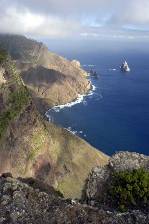 At the opposite extreme, the lower slopes of the island are barren expanses of reddish rock and crumbling cliffs, gouged by deep valleys that reach to the sea. Vegetation is sparse with only a few hardy plants and abundant prickly pear cactii thriving. Coastal walks are hot and dusty but lead to inviting rock pools where we swam and snorkeled with juvenile tropical fish. The steep coastal cliffs are spectacular (see photo) and provide nesting sites for several seabirds such as tropic birds, noddies and fairy terns. The fairy terns are one of our favourite tropical birds: pure white with purplish bills and big black eyes they flutter overhead making a low, resonant twanging call and when lit from behind by the sun they glow with a magical translucence. On the island's pastures another bird got our attention, the endangered wirebird, endemic to St Helena and with only about 400 adult birds remaining. This small plover, related to an African species, has particularly long legs, a dark cap, dark back and dark eye area, with a pale stripe around the crown and pale underparts. They nest in shallow scrapes on open grassland and in certain areas they are quite easy to spot, bobbing as they run.
At the opposite extreme, the lower slopes of the island are barren expanses of reddish rock and crumbling cliffs, gouged by deep valleys that reach to the sea. Vegetation is sparse with only a few hardy plants and abundant prickly pear cactii thriving. Coastal walks are hot and dusty but lead to inviting rock pools where we swam and snorkeled with juvenile tropical fish. The steep coastal cliffs are spectacular (see photo) and provide nesting sites for several seabirds such as tropic birds, noddies and fairy terns. The fairy terns are one of our favourite tropical birds: pure white with purplish bills and big black eyes they flutter overhead making a low, resonant twanging call and when lit from behind by the sun they glow with a magical translucence. On the island's pastures another bird got our attention, the endangered wirebird, endemic to St Helena and with only about 400 adult birds remaining. This small plover, related to an African species, has particularly long legs, a dark cap, dark back and dark eye area, with a pale stripe around the crown and pale underparts. They nest in shallow scrapes on open grassland and in certain areas they are quite easy to spot, bobbing as they run.
|
| |
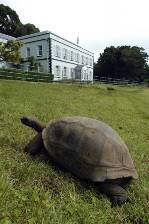 St Helena has a long and interesting history. First sighted in 1502 by a Portuguese commander, the island at once became an important provisioning stop for vessels en route to and from the Far East. For over 300 years it provided sailors with fresh water, fruit, fish and wood, until the advent of steam powered vessels and the opening of the Suez canal cut the once arduous 3 months voyage down to just a few weeks. In 1815 Napoleon Bonaparte, Emperor of France, was exiled to St Helena and in 1821 he died here. Longwood house, where he lived, is preserved exactly as it was and made a fascinating visit. Plantation House, built in 1792, is an imposing mansion set in beautiful grounds where six Giant tortoises, sent as gifts from the Seychelles, roam the lawn (see photo), one of them believed to be about 170 years old. The roads are single track and tortuous, winding into steep valleys in sharp hairpin bends and clinging to the hillsides. Every turn reveals a new panorama, always with the blue of the sea in the distance. Only from the very top of the island, where there is a 360 degree view, do you realise just how small the island really is. Just over 10 miles long by 6.5 wide it is 1200 miles from Africa and 1800 miles from S. America, a remote and special outpost in the South Atlantic.
St Helena has a long and interesting history. First sighted in 1502 by a Portuguese commander, the island at once became an important provisioning stop for vessels en route to and from the Far East. For over 300 years it provided sailors with fresh water, fruit, fish and wood, until the advent of steam powered vessels and the opening of the Suez canal cut the once arduous 3 months voyage down to just a few weeks. In 1815 Napoleon Bonaparte, Emperor of France, was exiled to St Helena and in 1821 he died here. Longwood house, where he lived, is preserved exactly as it was and made a fascinating visit. Plantation House, built in 1792, is an imposing mansion set in beautiful grounds where six Giant tortoises, sent as gifts from the Seychelles, roam the lawn (see photo), one of them believed to be about 170 years old. The roads are single track and tortuous, winding into steep valleys in sharp hairpin bends and clinging to the hillsides. Every turn reveals a new panorama, always with the blue of the sea in the distance. Only from the very top of the island, where there is a 360 degree view, do you realise just how small the island really is. Just over 10 miles long by 6.5 wide it is 1200 miles from Africa and 1800 miles from S. America, a remote and special outpost in the South Atlantic.
|
| |
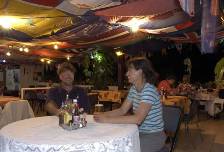 Our 'home away from home' during our stay in St Helena was Anne's Place, a haven for yachtsmen since 1975. Anne, the bubbling and fun-loving character who first opened it as a one-room restaurant in her own home, is still a dominant central figure, although the much expanded premises is now run by her son, Richard, and his wife, Jane. Flags from all over the world adorn the ceiling and visitor's books with entries right back to the early days fill a cupboard in one corner. Browsing through them filled us with nostalgia, as we could see when many friends on other boats had passed through and found our own entry from 1991. Offering a warm atmosphere, great food, a laundry service and the only public internet access on the island, we seemed to gravitate there on our way to or from any other venture to enjoy an ice-cold drink (see photo), meet other yachties or reminisce with Anne about 'the old days'. Our 9 days in St Helena flew by and we know we will come back again one day....
Our 'home away from home' during our stay in St Helena was Anne's Place, a haven for yachtsmen since 1975. Anne, the bubbling and fun-loving character who first opened it as a one-room restaurant in her own home, is still a dominant central figure, although the much expanded premises is now run by her son, Richard, and his wife, Jane. Flags from all over the world adorn the ceiling and visitor's books with entries right back to the early days fill a cupboard in one corner. Browsing through them filled us with nostalgia, as we could see when many friends on other boats had passed through and found our own entry from 1991. Offering a warm atmosphere, great food, a laundry service and the only public internet access on the island, we seemed to gravitate there on our way to or from any other venture to enjoy an ice-cold drink (see photo), meet other yachties or reminisce with Anne about 'the old days'. Our 9 days in St Helena flew by and we know we will come back again one day....
|
| |
April 5 2008
St. Helena - Ascension Island
Distance: 720 nm
Position: 7 55'S 14 25'W
|
 This has been a slow but beautiful 6 day passage with winds rarely over 10 knots from behind. In spite of our newly scrubbed hull there was not enough wind to sail at more than about 5 knots and for the first time on Wandering Albatross we were dreaming of a spinnaker. We had the pole up almost all the way, sailing goose-winged in calm sea (see photo). Frequent windshifts meant we had to jibe both the main and the jib at least once a day, always entertaining. The gentle blue days merged into silver, star-studded nights and time lost all importance as we drifted along in our own world, absorbed in the rhythm of the sea.
On the last morning the wind picked up and our dawn approach to Ascension became an exciting reach. A dark blue silhouette in the early morning light, the island was wreathed in its own cloud and veiled behind drifting bands of rain, through which shafts of sunlight probed like shining fingers. As the sun rose we could see the utterly barren volcanic landscape all but bristled with a remarkable array of radio masts, antennas, satellite dishes and radar installations: Ascension hosts important military bases for both the UK & USA and their presence dominates this small island.
As we motor-sailed the last few miles across an extensive 50' deep bank we were thrilled to count at least 15 green turtles, indistinct golden brown shapes rising up beneath the surface until their heads pop into the air to take a breath. The anchorage lay off a broad sweep of beach a short distance from the main village, Georgetown, where the cluster of low white buildings sat against a backdrop of red and black hills, all ancient volcanic craters. We set the anchor, dived over the side for a swim, enjoyed a hearty breakfast and had a few hours sleep before heading ashore to explore...
This has been a slow but beautiful 6 day passage with winds rarely over 10 knots from behind. In spite of our newly scrubbed hull there was not enough wind to sail at more than about 5 knots and for the first time on Wandering Albatross we were dreaming of a spinnaker. We had the pole up almost all the way, sailing goose-winged in calm sea (see photo). Frequent windshifts meant we had to jibe both the main and the jib at least once a day, always entertaining. The gentle blue days merged into silver, star-studded nights and time lost all importance as we drifted along in our own world, absorbed in the rhythm of the sea.
On the last morning the wind picked up and our dawn approach to Ascension became an exciting reach. A dark blue silhouette in the early morning light, the island was wreathed in its own cloud and veiled behind drifting bands of rain, through which shafts of sunlight probed like shining fingers. As the sun rose we could see the utterly barren volcanic landscape all but bristled with a remarkable array of radio masts, antennas, satellite dishes and radar installations: Ascension hosts important military bases for both the UK & USA and their presence dominates this small island.
As we motor-sailed the last few miles across an extensive 50' deep bank we were thrilled to count at least 15 green turtles, indistinct golden brown shapes rising up beneath the surface until their heads pop into the air to take a breath. The anchorage lay off a broad sweep of beach a short distance from the main village, Georgetown, where the cluster of low white buildings sat against a backdrop of red and black hills, all ancient volcanic craters. We set the anchor, dived over the side for a swim, enjoyed a hearty breakfast and had a few hours sleep before heading ashore to explore...
|
| |
April 10 2008
Ascension Island
|
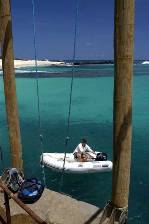 Like St Helena, Ascension Island is just a small speck in the vastness of the Atlantic Ocean and is subject to an almost endless swell. Wandering Albatross rolled constantly in the anchorage and large breakers were crashing onto the beach. The only landing place was a high, concrete pier just off the town and from the boat all we could see was white water surging around rocks near the jetty. But once we got closer in the dinghy we could see that there was a lower landing platform with steps up to the top and sturdy ropes to haul yourself out with (see photo) As the swells rose and fell we waited for just the right moment to dart in and leap out, then repeated the procedure to offload. All the local fishing boats were strung off on a long mooring line so we tied the dinghy alongside one of them. The sea was a fantastic, clear turquoise against the brilliant white sand of the beach - pure tropics! Great swarms of black triggerfish converged like marine piranhas onto fish scraps thrown into the water by the fishermen.
Like St Helena, Ascension Island is just a small speck in the vastness of the Atlantic Ocean and is subject to an almost endless swell. Wandering Albatross rolled constantly in the anchorage and large breakers were crashing onto the beach. The only landing place was a high, concrete pier just off the town and from the boat all we could see was white water surging around rocks near the jetty. But once we got closer in the dinghy we could see that there was a lower landing platform with steps up to the top and sturdy ropes to haul yourself out with (see photo) As the swells rose and fell we waited for just the right moment to dart in and leap out, then repeated the procedure to offload. All the local fishing boats were strung off on a long mooring line so we tied the dinghy alongside one of them. The sea was a fantastic, clear turquoise against the brilliant white sand of the beach - pure tropics! Great swarms of black triggerfish converged like marine piranhas onto fish scraps thrown into the water by the fishermen.
|
| |
 Due to the strategic importance of Ascension and the overwhelming military presence there we heard that no-one is allowed to own property nor is anyone really considered "permanent". The people that live there almost all come from somewhere else, many of them from St Helena, and although they may have spent most of their life on Ascension they still call St Helena home. Within minutes of landing on the jetty we were chatting to some fishermen and discovered we had mutual friends back in St Helena. One of the men offered to 'rent' us his car for just 5 pounds a day, which was a great stroke of luck.
With wheels we were able to explore the almost surreal volcanic landscape of the island (see photo),
Due to the strategic importance of Ascension and the overwhelming military presence there we heard that no-one is allowed to own property nor is anyone really considered "permanent". The people that live there almost all come from somewhere else, many of them from St Helena, and although they may have spent most of their life on Ascension they still call St Helena home. Within minutes of landing on the jetty we were chatting to some fishermen and discovered we had mutual friends back in St Helena. One of the men offered to 'rent' us his car for just 5 pounds a day, which was a great stroke of luck.
With wheels we were able to explore the almost surreal volcanic landscape of the island (see photo),  as barren as the moon but made even more alien by the hi-tech gadgetry on every hilltop, huge white satellite dishes and fields of radio antennas. Only the highest part of the island, Green Mountain, rising to 860m, has a thick cloak of vegetation, a jungle-like tangle of tree ferns, bamboo, pine trees, bananas and many other plants. While the rest of the island baked beneath a remorseless sun the mountain was cool and shady and we went on some lovely walks. Fairy terns were nesting on tree branches overhead and they fluttered above us making their strange, twanging call. Along the coast the sea errodes the volcanic rock into caves and fissures and we found some great blowholes (see photo)
We also enjoyed the opportunity to snorkel in the warm water amid schools of bright tropical fish. as barren as the moon but made even more alien by the hi-tech gadgetry on every hilltop, huge white satellite dishes and fields of radio antennas. Only the highest part of the island, Green Mountain, rising to 860m, has a thick cloak of vegetation, a jungle-like tangle of tree ferns, bamboo, pine trees, bananas and many other plants. While the rest of the island baked beneath a remorseless sun the mountain was cool and shady and we went on some lovely walks. Fairy terns were nesting on tree branches overhead and they fluttered above us making their strange, twanging call. Along the coast the sea errodes the volcanic rock into caves and fissures and we found some great blowholes (see photo)
We also enjoyed the opportunity to snorkel in the warm water amid schools of bright tropical fish.
|
| |
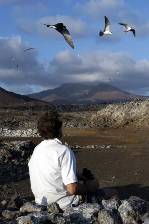 One of the highlights of our time in Ascension was the enormous colony of Sooty terns nesting at a place called Wideawake Fairs. Tens of thousands of these black and white terns breed there every year and each evening we went to visit them. The spectacle is amazing, the sky is filled with birds for as far as the eye can see and the ground is covered with them too. The noise is fantastic, a constant chattering, their call a shrill "wideawakewideawakewideawake", which gives them their local nickname.
They nest in loose groups and lay a single speckled egg onto bare rock or gravel.
One of the highlights of our time in Ascension was the enormous colony of Sooty terns nesting at a place called Wideawake Fairs. Tens of thousands of these black and white terns breed there every year and each evening we went to visit them. The spectacle is amazing, the sky is filled with birds for as far as the eye can see and the ground is covered with them too. The noise is fantastic, a constant chattering, their call a shrill "wideawakewideawakewideawake", which gives them their local nickname.
They nest in loose groups and lay a single speckled egg onto bare rock or gravel.
 There were birds at every stage of breeding, some still sitting on eggs, some with newly hatched chicks - tiny balls of brownish down that looked like miniature hedgehogs - and some with fully grown chicks that were just learning how to fly. Sitting on a rock in the middle of all this frenzied activity was mesmerising and the terns seemed as fascinated by us as we were by them. A non-stop stream of birds flew over our heads, pausing to stare down at us with bright black eyes, fluttering on translucent wings like some magical spirit (see photos)
There were birds at every stage of breeding, some still sitting on eggs, some with newly hatched chicks - tiny balls of brownish down that looked like miniature hedgehogs - and some with fully grown chicks that were just learning how to fly. Sitting on a rock in the middle of all this frenzied activity was mesmerising and the terns seemed as fascinated by us as we were by them. A non-stop stream of birds flew over our heads, pausing to stare down at us with bright black eyes, fluttering on translucent wings like some magical spirit (see photos)
|
| |
 But best of all were the turtles. Ascension is one of the most important breeding sites for green turtles in the Atlantic with around 4000 females coming ashore each season to lay their eggs on the 32 beaches. The anchorage was close to one of the main nesting beaches and each evening we could see the turtles swimming past on their way to shore. We went out several nights and early mornings to watch them in action. Bubbling with anticipation and excitement we walked slowly and quietly in the dark along the water's edge, where the breakers rushed and foamed like spilt champagne. Turtles are very sensitive to light and even the glow of a cigarette is enough to deter them from leaving the safety of the water to begin their laborious crawl up the sand, so we couldn't use a torch.
But best of all were the turtles. Ascension is one of the most important breeding sites for green turtles in the Atlantic with around 4000 females coming ashore each season to lay their eggs on the 32 beaches. The anchorage was close to one of the main nesting beaches and each evening we could see the turtles swimming past on their way to shore. We went out several nights and early mornings to watch them in action. Bubbling with anticipation and excitement we walked slowly and quietly in the dark along the water's edge, where the breakers rushed and foamed like spilt champagne. Turtles are very sensitive to light and even the glow of a cigarette is enough to deter them from leaving the safety of the water to begin their laborious crawl up the sand, so we couldn't use a torch.
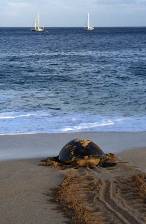 But once our eyes adjusted it wasn't pitch black and we could just make out the dark humps of numerous turtles, inching up the beach.
Green turtles dig deep body pits(see photo) prior to laying their eggs and above the high tide mark the entire beach was a mass of craters, some deep enough to fall into! It was remarkable to see such great numbers of turtles - while watching one laying her eggs and listening to her soft sighs in the night we suddenly became aware of two more lumbering up on either side of us and then a fourth appeared, almost crawling over the nester as she returned to the sea. As dawn crept into the sky we discovered a number of turtles that had miscalculated the timing and they persevered with nest covering even as the sun came up, flinging sand behind them with their powerful flippers. Finished at last, they sighed once more and awkwardly maneouvred around to face the sea. Ungainly on land, they dragged themselves towards the water as fast as they could (see photo) and as the first wave washed over them we couldalmost feel their relief. In moments they had vanished beneath the surface, back in their natural environment.
Ascension has been a truly memorable stop, we have seen and done so much in only 5 days. Ahead lies over 3000 miles to the Azores, much of it to windward.....
But once our eyes adjusted it wasn't pitch black and we could just make out the dark humps of numerous turtles, inching up the beach.
Green turtles dig deep body pits(see photo) prior to laying their eggs and above the high tide mark the entire beach was a mass of craters, some deep enough to fall into! It was remarkable to see such great numbers of turtles - while watching one laying her eggs and listening to her soft sighs in the night we suddenly became aware of two more lumbering up on either side of us and then a fourth appeared, almost crawling over the nester as she returned to the sea. As dawn crept into the sky we discovered a number of turtles that had miscalculated the timing and they persevered with nest covering even as the sun came up, flinging sand behind them with their powerful flippers. Finished at last, they sighed once more and awkwardly maneouvred around to face the sea. Ungainly on land, they dragged themselves towards the water as fast as they could (see photo) and as the first wave washed over them we couldalmost feel their relief. In moments they had vanished beneath the surface, back in their natural environment.
Ascension has been a truly memorable stop, we have seen and done so much in only 5 days. Ahead lies over 3000 miles to the Azores, much of it to windward.....
|
| |
| |
|


 A small high has been almost stationary over us for the past few days, bringing very light winds.
With the breeze rarely over 15 knots and more often under 10 knots progress has been slow - not the conditions we were expecting in these latitudes.
On the plus side the weather has been good with balmy, almost tropical days interspersed with beautiful nights, the sky ablaze with stars.
Yesterday morning we were approaching the island of Tristan da Cunha at dawn and had a spectacular view of the island as the sun came up, turning the tendrils of mist that clung to the upper slopes a vivid pink.
High and volcanic it rises steeply from the sea, scored by gullies and clad in bright green vegetation.
With just a narrow strip of flat land where the village of Edinburgh is located, it reminded us of the Azorean fajas (see photo below).
There is no sheltered anchorage here, just an open roadstead with poor holding on a rocky bottom, and as the wind had picked up to 25 knots overnight we were doubtful whether we would be able to land.
But as the early morning sunshine touched the colourful rooves of the village we nudged in to have a closer look (see photo).
A small high has been almost stationary over us for the past few days, bringing very light winds.
With the breeze rarely over 15 knots and more often under 10 knots progress has been slow - not the conditions we were expecting in these latitudes.
On the plus side the weather has been good with balmy, almost tropical days interspersed with beautiful nights, the sky ablaze with stars.
Yesterday morning we were approaching the island of Tristan da Cunha at dawn and had a spectacular view of the island as the sun came up, turning the tendrils of mist that clung to the upper slopes a vivid pink.
High and volcanic it rises steeply from the sea, scored by gullies and clad in bright green vegetation.
With just a narrow strip of flat land where the village of Edinburgh is located, it reminded us of the Azorean fajas (see photo below).
There is no sheltered anchorage here, just an open roadstead with poor holding on a rocky bottom, and as the wind had picked up to 25 knots overnight we were doubtful whether we would be able to land.
But as the early morning sunshine touched the colourful rooves of the village we nudged in to have a closer look (see photo).
 Lying roughly midway between Africa and South America and over 1000 miles south of St Helena, the island belongs to the UK.
With a population of about 250 this must be one of the most remote inhabited islands in the world.
The wind had whipped the sea into foaming crests and the ocean swell was crashing onto the black rocks of the beach.
There was no way we could anchor or launch the dinghy at that stage but thinking we would heave to for a few hours in the hopes that conditons would improve,
Gary spoke to the harbour master and the immigration official on the VHF radio to find out what the form was for coming ashore.
We were surprised to be told that we would not be allowed to land in any case - due to some work being done on the small harbour, "Health & Safety" regulations dictated that the entire waterfront had been declared out of bounds.
After our initial disappointment, we had to chuckle at the irony:
Having just sailed 1500 miles through the Southern Ocean we couldn't set foot ashore in case we fell down a hole or got run over by a reversing machine!
The petty bureaucracy of the outside world seemed out of place in this isolated place, but this time no amount of logic could persuade the officials to bend the rules.
Lying roughly midway between Africa and South America and over 1000 miles south of St Helena, the island belongs to the UK.
With a population of about 250 this must be one of the most remote inhabited islands in the world.
The wind had whipped the sea into foaming crests and the ocean swell was crashing onto the black rocks of the beach.
There was no way we could anchor or launch the dinghy at that stage but thinking we would heave to for a few hours in the hopes that conditons would improve,
Gary spoke to the harbour master and the immigration official on the VHF radio to find out what the form was for coming ashore.
We were surprised to be told that we would not be allowed to land in any case - due to some work being done on the small harbour, "Health & Safety" regulations dictated that the entire waterfront had been declared out of bounds.
After our initial disappointment, we had to chuckle at the irony:
Having just sailed 1500 miles through the Southern Ocean we couldn't set foot ashore in case we fell down a hole or got run over by a reversing machine!
The petty bureaucracy of the outside world seemed out of place in this isolated place, but this time no amount of logic could persuade the officials to bend the rules.
 One of the main reasons we wanted to stop at Tristan da Cunha was to see yellow-nosed albatrosses at their breeding site.
This species has a very restricted breeding range and nests only on islands in the Tristan archipelago (Tristan, Inaccessible and Nightingale) and at Gough Island about 250 miles to the southeast.
The majority of the colonies are on Tristan itself.
We spent several hours hove to about a quarter mile offshore and were rewarded by a constant stream of these beautiful birds soaring past.
They are particularly pretty with dark upper wings, a white rump, white underside, a pale grey wash across their heads and a bright yellow stripe on top of an otherwise blackish bill (see photo).
Like so many albatross species, these birds are listed as "endangered" due to a rapid rate of decline over the last 20-30 years.
The primary threat is from longline and trawling operations off the coasts of Brazil and southern Africa, where the birds tend to forage in the rich waters.
The good news is that an Albatross Task Force operates in both these key regions, part of the international "Save the Albatross" campaign, teaching fishermen how to implement simple but effective measures to prevent seabird mortality.
To learn more about their vital work and how you can help support it, visit www.savethealbatross.net.
One of the main reasons we wanted to stop at Tristan da Cunha was to see yellow-nosed albatrosses at their breeding site.
This species has a very restricted breeding range and nests only on islands in the Tristan archipelago (Tristan, Inaccessible and Nightingale) and at Gough Island about 250 miles to the southeast.
The majority of the colonies are on Tristan itself.
We spent several hours hove to about a quarter mile offshore and were rewarded by a constant stream of these beautiful birds soaring past.
They are particularly pretty with dark upper wings, a white rump, white underside, a pale grey wash across their heads and a bright yellow stripe on top of an otherwise blackish bill (see photo).
Like so many albatross species, these birds are listed as "endangered" due to a rapid rate of decline over the last 20-30 years.
The primary threat is from longline and trawling operations off the coasts of Brazil and southern Africa, where the birds tend to forage in the rich waters.
The good news is that an Albatross Task Force operates in both these key regions, part of the international "Save the Albatross" campaign, teaching fishermen how to implement simple but effective measures to prevent seabird mortality.
To learn more about their vital work and how you can help support it, visit www.savethealbatross.net.



















